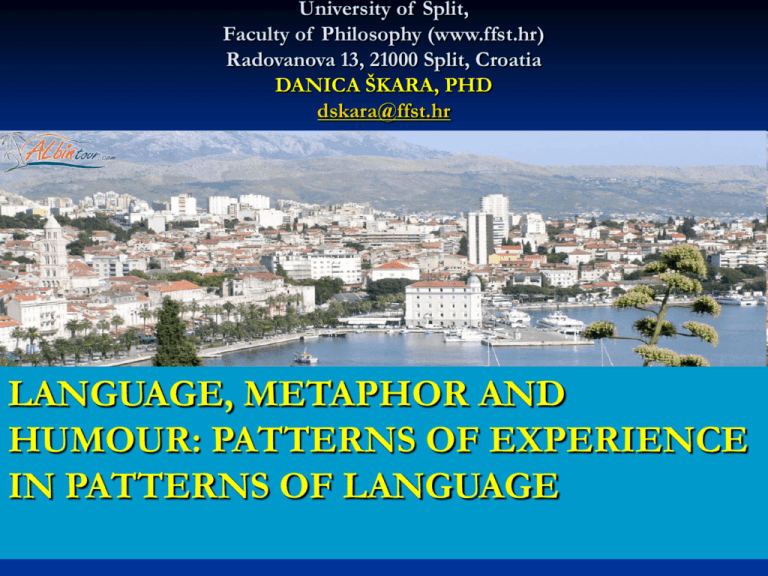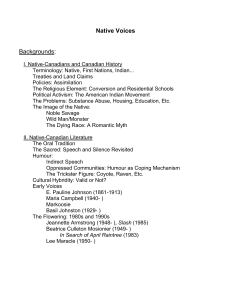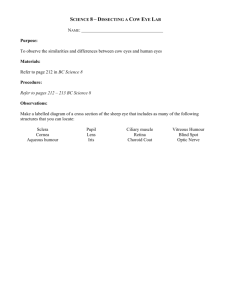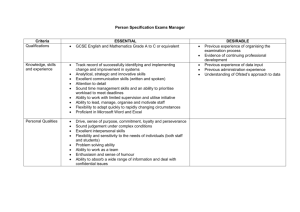University of Split, Faculty of Philosophy (www.ffst.hr) Radovanova
advertisement

University of Split, Faculty of Philosophy (www.ffst.hr) Radovanova 13, 21000 Split, Croatia DANICA ŠKARA, PHD dskara@ffst.hr LANGUAGE, METAPHOR AND HUMOUR: PATTERNS OF EXPERIENCE IN PATTERNS OF LANGUAGE Introduction Issues to be considered: The relationship between language, metaphor and humour in order to attain a better understanding of the cognitive patterns of language. Cognitive theory is outlined (G. Lakoff, M. Turner, G.Fauconnier, K. Feyaerts, T. Veale, etc.) and used in humour and metaphor interpretation. A limited sample of political metaphors was selected from public media and relevant databases. A number of properties which form the basis for various theories of humour were explored with special reference to the incongruity theory and language patterns: schemas, scripts, domains, frames, mental spaces... Our starting point is based on the following assumption: ‘Metaphor appears as the instinctive and necessary act of the mind exploring reality and ordering experience.’ (J.M. Murry, 1931: 1-2) ‘The mind is a connecting organ..’ Everything we experience is reflected in the brain by neurons which communicate to form what are called neural networks. The brain creates knowledge /understanding of the world. I.A. Richards, (The Philosophy of Rhetoric , Oxford University Press: New York and London, 1936:125) claims that ‘The mind is a connecting organ, it works only by connecting and it can connect any two things in an indefinitely large number of different ways. ‘ ANALOGICAL REASONING We often use similarity/samenes in our thinking, where even distant fields may be used to help understand a given frame or situation. Dienhart (1999: 98) claims: "Making comparisons is a very human occupation. We spend our lives comparing one thing to another, and behaving according to the categorizations we make. Patterns govern our lives, be they patterns of material culture, or patterns of language. Growing up in any society involves, in large measure, discovering what categories are relevant in the particular culture in which we find ourselves. (...) 'Things' are classified as the same, similar or different, and we construct mental 'boxes' in which to put objects which 'match' in some way. A fundamental component of analogical reasoning and of metaphorical conceptualization is undoubtedly the partial mapping of a source to a target and the transfer of inferences and structures that it creates.’ The analogy is guided by a pressure to identify consistent structural parallels between the roles in the source and target domain.’ (see Gentner, 1983). Oppositeness According to Cruse, D.A. (1986:197) ‘Of all the relations of sense the semanticists propose, that of oppositeness is probably the most readily apprehended by ordinary speakers. (…) Philosophers and others from Heraclites to Jung have noted the tendency of things to slip into their opposite states; and many have remarked on the thin dividing line between love and hate… ’ Language and mind The mind is never aimless! Images of the external world obtained by our bodily capacities are framed by linguistic patterns/words. Language can be seen as a repository of world knowledge, a structured set of meaningful categories that help us deal with new and old experiences. Literal and figurative meaning The most basic or fundamental level of linguistic description of reality is that of literal terms. Literal concepts are those entities whose meanings specify truth conditions for the objects and events that exist objectively in the world. In the traditional analyses, words in literal expressions denote what they mean according to dictionary usage. When figurative meanings are interpreted via literal meanings, there is a confusion in our mind which results with humour. kick somebody's ass/butt = to punish or defeat someone To rain cats and dogs(=it is raining very hard) to beat around the bush= to avoid or delay talking about something embarrassing or unpleasant Figurative meaning Figurative speech is a pervasive imaginative structure in human understanding of the world (see Lakoff & Johnson, 1980). Metaphors allow language to free itself from the function of direct description and to set up a an indirect relationship between words and reality. Reasons: strategically used in order to avoid responsability, to define complex reality, to manipulate with concepts (euphemisms), political correctness (vertically challenged, pushing up daisies, economical with the truth, financially embarrassed (poor)), comfort women, tottaly dependent (idiot). The humorous euphemism can help the people facing the harsh reality with ease. CONTRADICTIONS, AMBIGUITIES WE LIVE BY Michael Mulkay (1988) claims that people interact with one another using two basic modes of communication: serious and humorous In a serious mode, we attempt to be consistent and coherent, we seek to avoid ambiguity and contradiction (Grice’s maxims of communication) But, complex realities often produce contradictions, incongruity, which, the serious mode of discourse is unable to handle easily. Mulkay (1988) defines humour as a way for people to deal with this multiplicity and inherent contradictions in their communication. It enables people to negotiate difficult interpersonal situations. LANGUAGE ECONOMY No language can have a separate word for each and every concept a speaker might wish to convey. It would be an enormous burden on our memory. In order to save our mental energy, we often use a word with an enlarged reference (polysemy). Using metaphors becomes an efficient and economical means of explanation of reality. This is an example of language economy, or 'economical percept' (Gibbson, 1966). > we memorize one word form for multiple meanings. e.g. The art of taxation is to pluck the goose for the largest amount of feathers with the smallest amount of hissing. PATTERNS OF EXPERIENCE IN PATTERNS OF LANGUAGE Languages have a tendency to impose structure upon the real world by treating some distintions as crucial, and ignoring others. Sometimes the motivation is supplied by cultural/social norms, rather than by external reality SCHEMAS, FRAMES, CONCEPTUAL DOMAINS ... Lakoff (Lakoff and Johnson 1980; Lakoff 1987) > our worldviews are based largely on different patterns, frames, schemas, concepts, that provide us with structure for our thinking. Allport (1954) notes that knowledge is said to be clustered; we fit our new experiences into one of our existing categories. The task of this patterned behaviour is to provide maximum information with the least cognitive effort. A schema is a dynamic mental framework centering around a specific theme, that helps us to organize social information (see R.A. Martin:2007). New information that falls within an individual's schema is easily remembered. Frames are not arbitray patterns of knowledge. They are knowledge units organized around a certain concept. Fillmore (1985: 224) notes that ‘a frame represents the particular organization of knowledge which stands as a prerequisite to our ability to understand the meanings of the associated words.’ In the behaviorism approach, behavioral scripts are a sequence of expected behaviors for a given situation. Mental spaces (Fauconnier, 1994) can be thought of as temporary containers for relevant information about a particular domain . These concepts can be used to explain the nature of incongruity in humour. If something contradicts our schema, script it may be encoded or interpreted as an exception or funny. Though not all blends are humorous, blending does seem to be an inherent feature of humor. Koestler (1964: 51) writes: "The sudden bisociation of an idea or event with two habitually incompatible matrices will produce a comic effect, provided that the narrative, the semantic pipeline, carries the right kind of emotional tension. ‘ ASSOCIATIVE NETOWORK Associative connections between concepts have different density, therefore the semantic distance between different scripts, frames can be conceived as closer or farther. http://www.brown.edu/Research/Memlab/py47/diagrams/02-Collins-Loftus.jpg RELEVANT STIMULI Schemas are generally thought to have a level of activation, which can spread among related schemas. Which schema is selected can depend on factors such as current activation, accessibility and relevance. Those schemas and words that are more relevant (Sperber &Wilson, 1986) in the current context remain activated; those that least relevant are suppressed or reduced in activation. The relevance-theoretic account is based on Grice’s (Grice 1961, 1989: p. 368-72) central claims that utterances automatically create expectations which guide the hearer towards the speaker’s meaning. Grice described these expectations in terms of a Co-operative Principle and maxims of Quality (truthfulness), Quantity (informativeness), Relation (relevance) and Manner (clarity) which speakers are expected to observe. How Grice’s maxims are violated in political context ’innapropriate relationship with the truth’ Politicians are the same all over. They promise to build a bridge even where there is no river. (Nikita Khrushchev) He is the cutlery man of politics: born with a silver spoon in his mouth, speaks with a fork tongue, and knifes his colleagues in the back. In Mexico, an air conditioner is called a 'politician' because it makes lots of noise but doesn't work well. Gordon Brown's budget speech sounded like a blindfolded man riding a unicycle on the rim of a volcano. Margaret Thatcher has the mouth of Marilyn Monroe and the eyes of Caligula. (François Mitterand) GRADED SALIENCE HYPOTHESIS The choice of activated word frames can be explained in terms of the graded salience hypothesis (Giora, 2002). Salience includes senses that are more frequent, conventional, or prototypical. METAPHORS The successful use of metaphor is a matter of perceiving similarities. (Aristotle) Within a framework of a cognitive approach to metaphor, it has been described in terms of transfer from one cognitive domain (source) to another (target) domain: Life is a battle. People tend to draw upon experiences in one area of life in order to give fresh insights and understanding to experiences in another. Conceptual metaphors source target Many scholars agree that metaphors do more than call our attention to some already existing similarities. According to Beck, B. (1987, 11) 'They force the mind to construct a higher-order linkage between the entities referred to'. Metaphor is not simply the substitution of one concept or image for another. Instead, it encompasses a complete transformation whereby two originally distinct meanings are merged so that a new meaning is effected. ( Edwards, 1997, 29). The conceptual blending supported by Turner and Fauconnier (1995) They claim that two domains blend into a separate conceptual space which takes on aspects of both domains and has an emergent structure of its own. Conceptual integration—"blending"—is a general cognitive operation on a par with analogy, recursion, mental modeling, conceptual categorization, and framing. Much of the power of metaphor stems from the fact that the source and target mental spaces may belong to superficially very different conceptual domains. HUMOUR The secret source of humor itself is not joy but sorrow. There is no humor in heaven" [Mark Twain] So many tangles in life are ultimately hopeless that we have no appropriate sword other than laughter. (Gordon W. Allport) Dogs laugh, but they laugh with their tails. What puts man in a higher state of evolution is that he has got his laugh on the right end. (Max Eastman) Laughter is an orgasm triggered by the intercourse of sense and nonsense. Humour is the tendency of particular cognitive experiences to provoke laughter and provide amusement. It is one of the methods that people use to influence each other in a complex variety of ways. It can be used to push boundaries and rebel against social norms and taboos, it proveds us with relief from our tensions that arise from restraint in conforming to "social requirements. Humor research deals with a wide variety of issues but many of them can be categorized according to the major types of humor theories. Three essential themes are repeatedly observed in the majority of humour theories: Theories of incongruity, inconsistency, contradiction or bisociation Theories of superiority, or criticism, or hostility (aggressiveness) Theoris of release, or relief, or relaxation. In recent years a considerable amount of work has been done in the development of formal theories of humour (N. Norrick (1986), V. Raskin, (1985), S. Attardo (1994), A. Koestler (1964)). Many creativity researchers consider humour to be essentially a type of creativity. Both humour and creativity involve a switch of perspective. A Koestler (1964) said that creativity involves bringing together elements of different domains. Creative thought is a mental process involving the discovery of new ideas or concepts, or new associations of the existing ideas or concepts. In order to be creative, you need to be able to view things from a different perspective. Arthur Koestler (1964) introduced the term bisociation, i.e. the specific ‘two-planed’ nature of any creative act. A sudden bisociation of two incompatible associative contexts, frame of references causes ‘a sudden jump from one matrix to another’. T.C. Veatch (1998) utilizes the established idea that humour contains two incongruous elements; one element is socially normal while the other constitutes a violation of the ‘subjective moral order’. If incongruity based humour theories are on the right track, the vast majority of humour shared between people must involve, at minimum, two conceps. (incongruous-congrous). Victor Raskin’s script-based semantic theory of humour identifies a semantic model capable of expressing incongruities between semantic scripts in verbal humor. Raskin (1985:99) stated the following: ‘A text can be characterized as a single-joke carrying text if both of the following conditions are satisfied: (I) the text is compatible fully or in part, with two different scripts; and (II) ‘the two scripts with which the text is compatible are opposite in a special sense..’ R. A. Martin (2007: 90) ‘In order for the text to be viewed as humorous this second, overlapping script must be opposite to the first.’ Script oppositions may be manifested in terms of such pairs as good-bad, life-death, high-low, clean-dirty, real-unreal, desirableundesirable, etc. To induce a shift from one frame to another requires deliberate use of linguistic strategies and increases the cognitive demands on audiences. Humor often turns on an abrupt and unexpected shift from one frame to another. (Coullson, 2001), e.g. Tony Blair does the work of two men — Laurel and Hardy. Laws are like sausages. It's better not to see how they are made. (Otto Von Bismark ) Coulson (2001) has proposed a theory in which two incongruous mental spaces are activated at once, and resolved in the blend. A great many philosophers have tried to define humor in general as a "contrast," or "conflict," or "mixture" of desirable with undesirable qualities. It is quite evident that cognitively oriented researchers generally view some type of incongruity as being a defining characteristic of humour. The incongruity theory states that humor is perceived at the moment of realization of incongruity between a concept involved in a certain situation and the real objects thought to be in some relation to the concept. e.g. I only want your best – your money. Humor arises when one of two opposing scripts is activated. real/unreal human being/animal A politician is an animal that can sit on the fence and yet keep both ears to the ground. man Animal monkey politician=animal/monkey US president: G.Bush perfection/imperfection classical/modern Linguistic sign: Sound image associated with a ‘wrong’ concept due to the similarity of the two concepts blowing sucking In general, humour is perceived as an interaction of cognitive, emotional, and social elements. Words and concepts are used in ways that are surprising, unusual, and incongruous, activating concepts with which they are not normally associated. For a text to be a joke, its final constituent must be cognitively distant from the prototype , sharing the least amount of common features with the previouas constituents. ON THE SIMILARITY OF HUMOUR AND FIGURATIVE SPEECH 1 The deep cognitive similarity between metaphor and humour is easy to recognize, and this has actually long been noticed and discussed by numerous scholars. Both metaphor and humor seem to refer to two different but related images or ideas. METAPHOR: + + metaphor=mapping between domains (target and source) , cognitve spaces, frames similarity, analogical reasoning, small distance between frames Novelty, creativity, a switch of perspective , incompatibility with literal meaning/conventional meaning Grice’s maxims and graded saliance are not applied in metaphors HUMOUR + _ HUMOUR=mapping between two opposite, incongrous scripts, frames, schemas or mental spaces. Two juxtaposed concepts stem from disparate ontological domains, e.g. concrete vs. abstract, inanimate vs. animate, nonhuman vs. human, with relevant attributes being transferred from one to the other. contradiction, ambiguity, cognitively distant frames, cognitive effort Violation of the subjective moral order, frames include desirable/undesirable qualities, real/unreal sitaution, evokes pleasure and laugh (cognitive satisfaction ) Words are used in ways that are surprising, unusual and incongrous Non conventioanl meaning is activated (violation of Grice’s maxims and the graded salience theory), novelty and creativity The distance between the source domain and target domain may be perceived as the basis of humour. Greater distance, greter incongruity. POLITICAL HUMOUR The man is by nature a political animal (Aristotle) Metaphors play a central role in public discourse, as they shape the structure of poltical categorization and argumentation. The results of the analysis of the sample consisting of 200 political jokes show the following: The most frequent conceptual framework used to define politics and politicians is animal world (monkey, ass, dog, fox, lion, bull, owl, etc.), Symbolic meaning of animals is evoked. e.g. A politician is an animal that can sit on the fence and yet keep both ears to the ground. I like pigs. Dogs look up to us. Cats look down on us. Pigs treat us as equals. (Winston Churchill) In general, politicianas are considered to be lyers, irresponsible people, gamblers, whores, etc. Note: to play politics=to use a situation or the relationships between people for your own advantage Humor and politics have their own frame of reference Input space 1: Humour=that quality which appeals to a sense of the ludicrous or absurdly incongruous Input space 2: Politics= ideas and activities relating to gaining and using power in a country, city etc. Blend: incongruous ideas and activities relating to gaining power Generic space: irresponsible politics/politicians Politician=Piano player in a whorehouse My choice early in life was either to be a piano-player in a whorehouse or a politician. And to tell the truth, there's hardly any difference. (Harry Truman) In Mexico, an air conditioner is called a 'politician' because it makes lots of noise but doesn't work well. A politician is an appendix: useless when inert but dangerous when active. I regard the law court not as a cathedral, but as a casino. A politician is an animal that can sit on the fence and yet keep both ears to the ground. An election is coming. Universal peace had been declared, and the foxes have a sincere interest in prolonging the lives of the poultry. (George Eliot ) The ultra-modern politician is an ink-blot test in which the electors can read anything they want. His argument is as thin as the homeopathic soup that was made by boiling the shadow of a pigeon that had been starved to death. (Abraham Lincoln) America: "We have Barack Obama, Stevie Wonder, Bob Hope and Johnny Cash." Croatia: "We have Ivo Sanader, no wonder, no hope and no cash.“ You want a friend in Washington? Get a dog. (H.S. Truman) A official Gallup survey polled over women with a question: Would you sleep with former US president Bill Clinton? 1% said, ‘No’. 2% said, ‘Yes’ 97% said, ‘Never again’ Conclusion It is not by chance that political, social, ethnic and obscene themes are statistically prevalent in contemporary jokes. Political humour is based on the two incompatible associative contexts, opposing, contradictory frames/scripts. Statistically, the most frequent source domain is the world of animals, moral order, games, etc. Word play is often used, idioms and proverbs often served as a source of humorous meaning. Different linguistic means are used to evoke pleasurable concepts. In politics, the explanatory function of metaphors is often subjected to the goal of manipulation, which means that metaphors are often primarily selected for their emotional and strategic effect, e.g. daizzy cutter, axes of evil, friendly fire, etc. With the aid of metaphors and humour speakers render experience intelligible, and by means of them they adjust to their environment.





